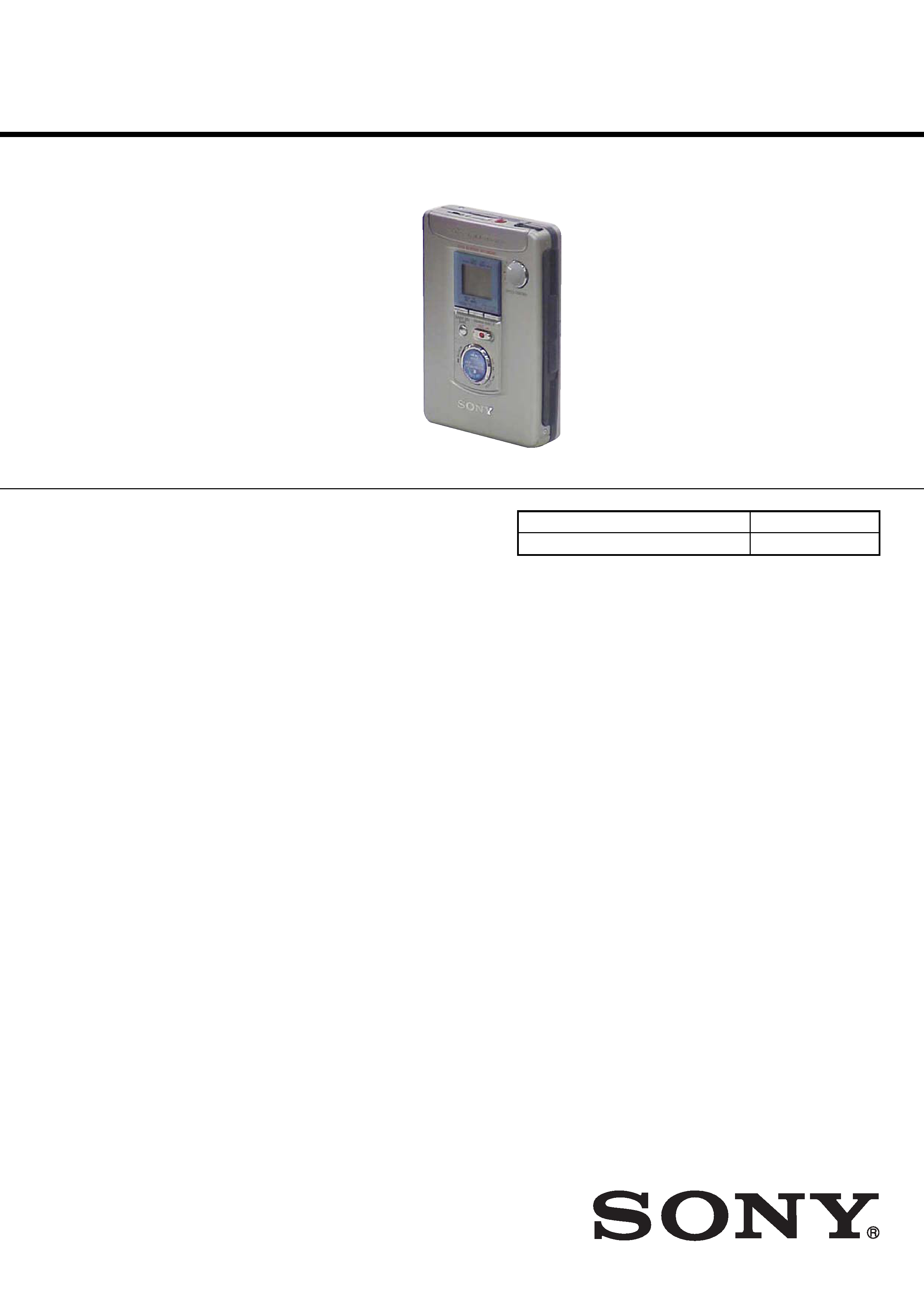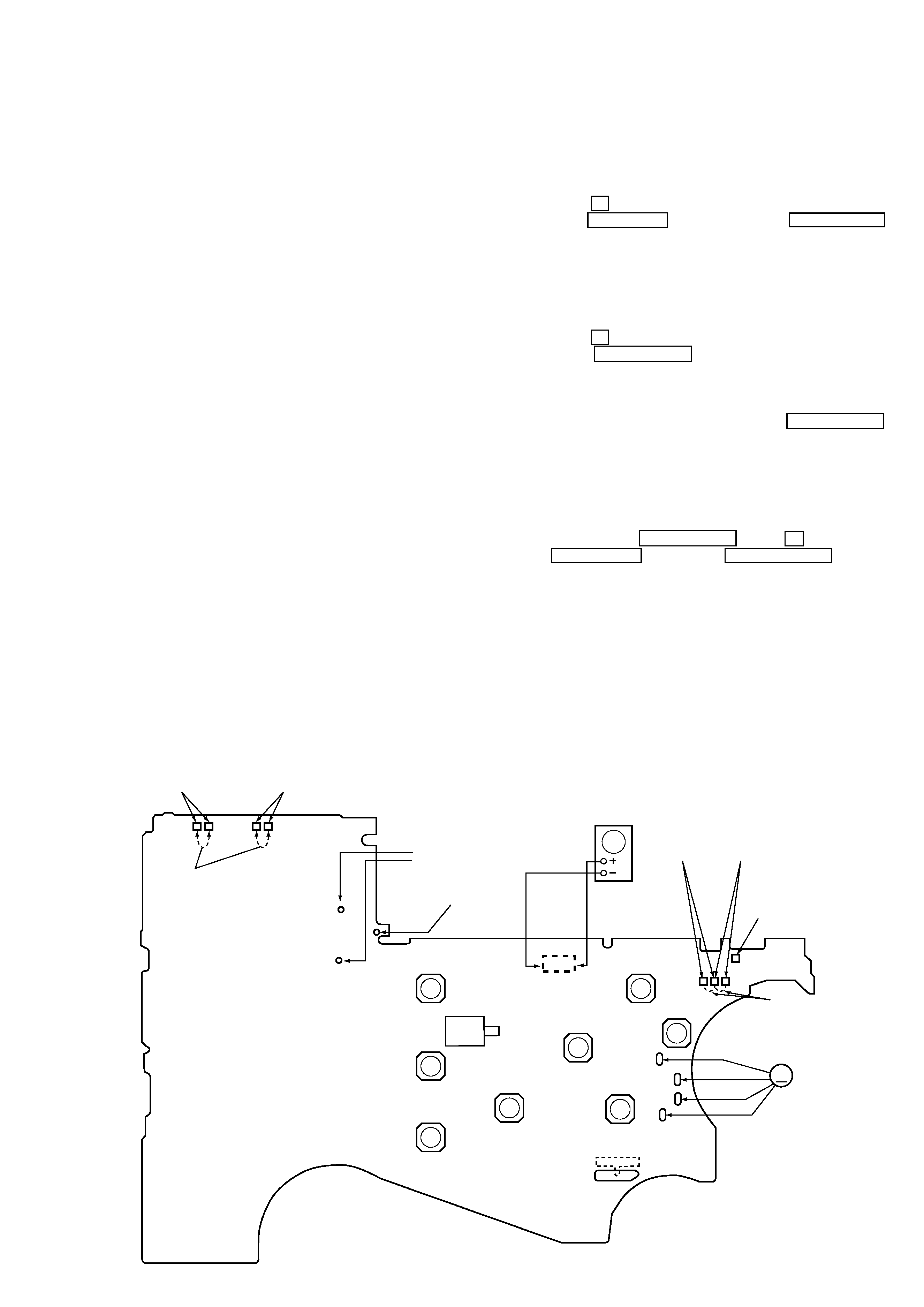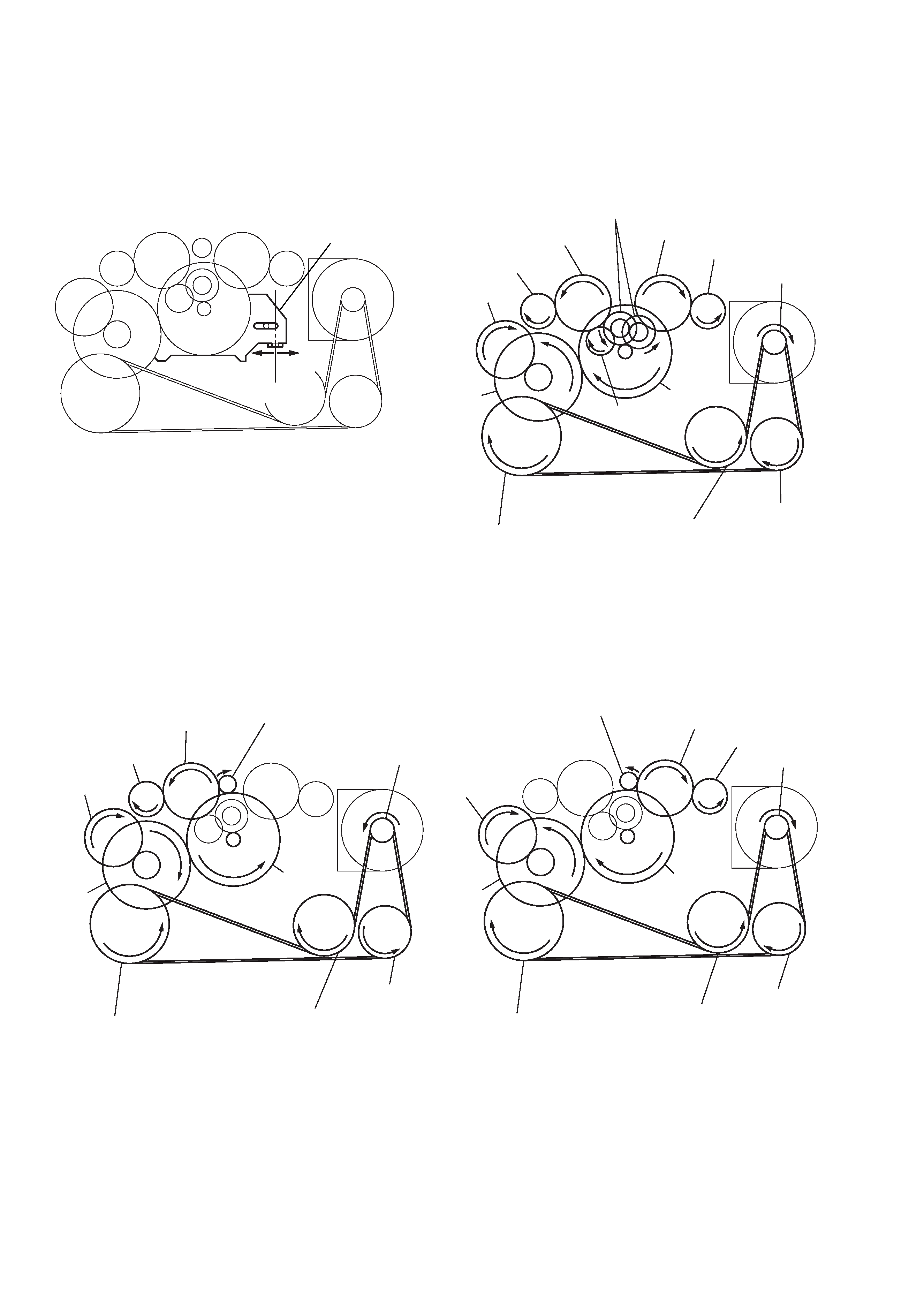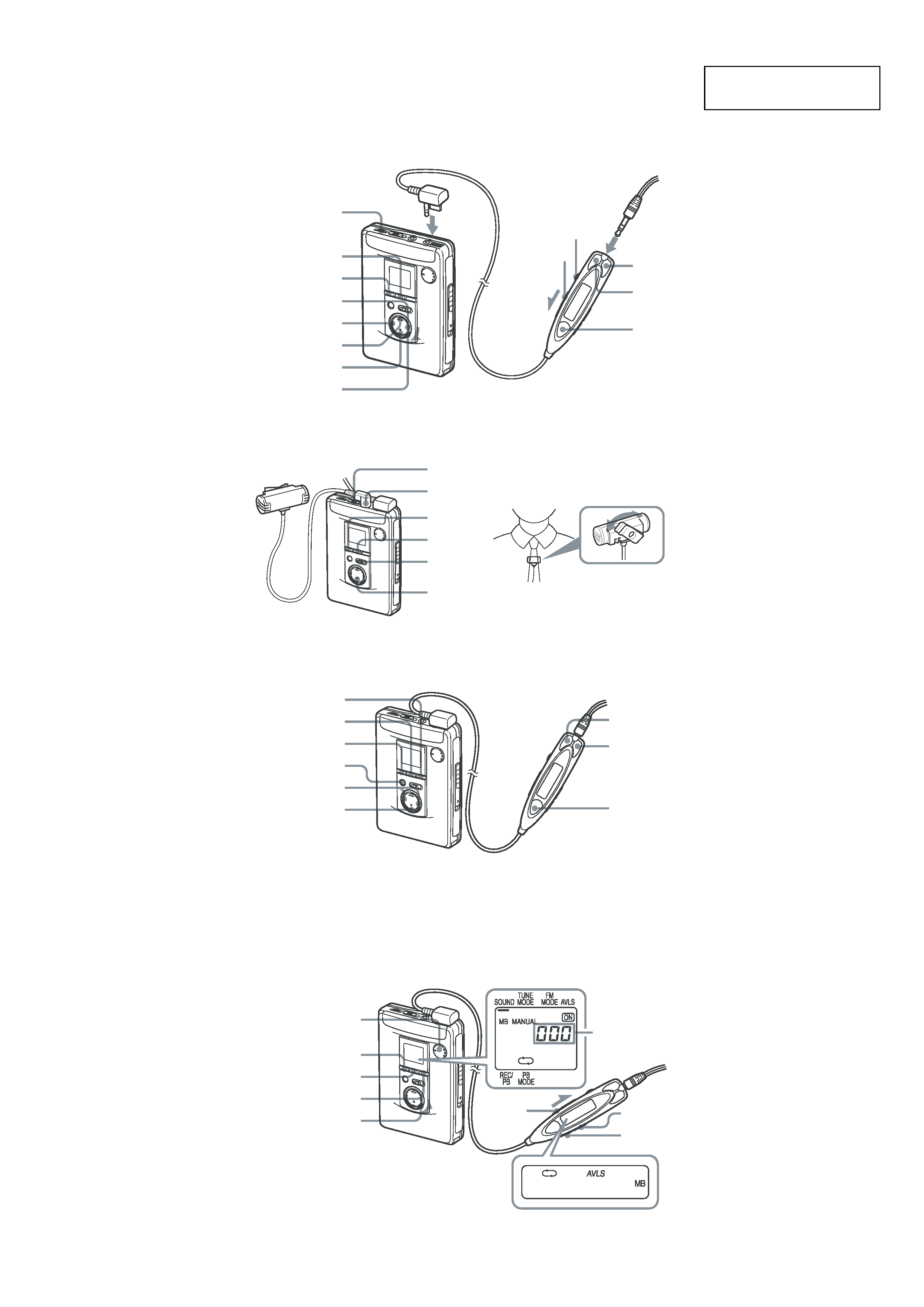
WM-GX780/GX788
US Model
AEP Model
WM-GX788
E Model
Chinese Model
WM-GX780/GX788
Tourist Model
WM-GX788
SERVICE MANUAL
Ver 1.1 2003. 10
RADIO CASSETTE-CORDER
Model Name Using Similar Mechanism
NEW
Tape Transport Mechanism Type
MF-WMGX788-162
SPECIFICATIONS
Sony Corporation
Personal Audio Company
Published by Sony Engineering Corporation
9-877-201-02
2003J16-1
© 2003.10
Radio section
Frequency range
FM:
87.5 - 108 MHz
AM:
530 - 1 710 kHz (North, Central,
and South America)
531 - 1 602 kHz (other
countries/regions)
Tape section
Frequency response
Playback: 40 - 15 000 Hz
Recording/playback: 100 - 8 000 Hz
Output
Headphones (i) jack
Load impedance 8 - 300
Input
Microphone (MIC) jack
General
Power requirements
1.5 V
Rechargeable battery
One R6 (size AA) battery
Dimensions (w/h/d)
Approx. 77.1
× 108.0 × 22.5 mm
(31/8
× 43/8 × 29/32 inches) excl. projecting
parts and controls
Mass
Approx. 152 g (5.4 oz) (main unit only)
Supplied accessories
AC power adaptor (1)
Battery case (1)
Stereo headphones or earphones with
remote control (1)
Charging stand (1)
AC plug adaptor (1) (Saudi Arabian
model only)
Rechargeable battery (NH-14WM(A),
1.2 V, 1 350 mAh (min), Ni-MH) (1)
Rechargeable battery carrying case (1)
Carrying pouch (1)
Stereo microphone (1)
Design and specifications are subject to
change without notice.
Photo: WM-GX788

Notes on chip component replacement
·Never reuse a disconnected chip component.
· Notice that the minus side of a tantalum capacitor may be
damaged by heat.
Flexible Circuit Board Repairing
·Keep the temperature of soldering iron around 270°C
during repairing.
· Do not touch the soldering iron on the same conductor of the
circuit board (within 3 times).
· Be careful not to apply force on the conductor when soldering
or unsoldering.
SAFETY-RELATED COMPONENT WARNING!!
COMPONENTS IDENTIFIED BY MARK 0 OR DOTTED LINE WITH
MARK 0 ON THE SCHEMATIC DIAGRAMS AND IN THE PARTS
LIST ARE CRITICAL TO SAFE OPERATION. REPLACE THESE
COMPONENTS WITH SONY PARTS WHOSE PART NUMBERS
APPEAR AS SHOWN IN THIS MANUAL OR IN SUPPLEMENTS
PUBLISHED BY SONY.
TABLE OF CONTENTS
WM-GX780/GX788
2
UNLEADED SOLDER
Boards requiring use of unleaded solder are printed with the lead-
free mark (LF) indicating the solder contains no lead.
(Caution: Some printed circuit boards may not come printed with
the lead free mark due to their particular size)
: LEAD FREE MARK
Unleaded solder has the following characteristics.
· Unleaded solder melts at a temperature about 40 °C higher than
ordinary solder.
Ordinary soldering irons can be used but the iron tip has to be
applied to the solder joint for a slightly longer time.
Soldering irons using a temperature regulator should be set to
about 350 °C .
Caution: The printed pattern (copper foil) may peel away if the
heated tip is applied for too long, so be careful!
· Strong viscosity
Unleaded solder is more viscous (sticky, less prone to flow) than
ordinary solder so use caution not to let solder bridges occur
such as on IC pins, etc.
· Usable with ordinary solder
It is best to use only unleaded solder but unleaded solder may
also be added to ordinary solder.
1. SERVICE NOTE ······························································· 3
2. GENERAL ·········································································· 5
3. DISASSEMBLY
3-1. Case Block Assy ····························································· 6
3-2. Button Rec, Button Assy ················································· 7
3-3. Cassette Lid Assy ···························································· 7
3-4. Ornament Block Assy Reel, Flexible Retainer ··············· 8
3-5. MAIN Board, Belt (F0) ·················································· 8
3-6. Motor (M901) ································································· 9
3-7. Bracket (cassette) Assy, Holder (FA) Assy ····················· 9
3-8. Pinch Lever (RA) Assy, Pinch Lever (NA) Assy ·········· 10
3-9. Magnetic Head (HP901) ··············································· 10
4. MECHANICAL ADJUSTMENT ································ 11
5. ELECTRICAL ADJUSTMENT ·································· 11
6. DIAGRAMS ······································································ 12
6-1. Block Diagram ······························································ 13
6-2. Printed Wiring Board (Side A) ······································ 14
6-3. Printed Wiring Board (Side B) ······································ 15
6-4. Schematic Diagram (1/2) ·············································· 16
6-5. Schematic Diagram (2/2) ·············································· 17
6-6. IC Block Diagrams ······················································· 18
6-7. IC Pin Function Discription ·········································· 19
7. EXPLODED VIEWS
7-1. Case Section ·································································· 21
7-2. Main Section ································································· 22
7-3. Mechanism Deck Section (MF-WMGX788-162) ········ 23
8. ELECTRICAL PARTS LIST ······································· 24

WM-GX780/GX788
3
SECTION 1
SERVICE NOTE
[Service Mode]
The service mode enables to operate the mechanism of WM-GX780/
GX788 while the MAIN board is opened.
Rotation of the idler gear (A) (S side) is detected using the photo-
reflector (PH701) in the WM-GX780/GX788. PH701 is located on
the MAIN board, therefore the rotation of the idler gear (A) (S side)
cannot be detected by PH701 when the MAIN board is removed.
As a result, the motor cannot be controlled and cannot run correctly.
To repair the machine after the MAIN board is removed while the
main power is turned on, follow the procedures as described below.
1. Setting
1)
Remove the cabinets referring to section "3. DISASSEMBLY".
Open the MAIN board.
2)
Connect the motor (M601) and the plunger solenoid (PM901)
to the MAIN board using the jumper wires. When the extension
jig (1-769-143-11) (10 wires as a set) is used, they can be
connected easily.
3)
Short the TAPE DETECT switch (S303), REV TUME switch
(S503), FWD TUME switch (S502) and ATS switch (S302).
4)
Connect an AF oscillator to resistor (R712).
5)
Connect DC 1.3 V from external regulated power supply to
`
and
' terminals of the battery.
2. PRE-SET status
The PLAY, FF and REW modes can be entered only from the PRE-
SET status.
1)
Check that the slider (NR) is in the center position (S801), and
the FWD/REV switch is also in the center position. When
these switches are not in the center position, set them to the
PRE-SET status as follows.
2)
Move the FWD/REV switch (S801) to the same position as the
slider (NR) is set.
3)
The slider (NR) can be moved when the main power of the
regulated power supply is turned OFF once then back ON.
Move the FWD/REV switch (S801) to the center position in
synchronism with the timing when the slider (NR) is moved.
3. FF, REW modes
1)
Check that the PRE-SET status is set.
2)
Connect square wave or sine wave to resistor (R712). (See
illustration below.)
3)
Press the x switch (S703) to enter the STOP mode.
4)
Press the FF PRESET+ switch (S708) and the REW PRESET
switch (S707).
4. PLAY mode
1)
Check that the PRE-SET status is set.
2)
Connect square wave or sine wave to resistor (R712). (See
illustration below.)
3)
Press the x switch (S703) to enter the STOP mode.
4)
When the nNREPEAT switch (S709) of the MAIN board
is pressed, the slider (NR) moves once to the F side then moves
to the R side. When the FWD/REV switch (S801) is pressed
in the synchronism with the above timing, the machine can
enter the PLAY (R side) mode. Press the nNREPEAT
switch (S709) again, and move the FWD/REV switch (S801)
in the synchronism with the motion of slider (NR). It enables
the machine to enter into the PLAY (F side) mode.
Note 1: When you fail to enter the PLAY mode, re-start from step
1) PRE-SET status.
Note 2: Regarding the nNREPEAT (S709), x (S703),
FF PRESET+ (S708), and REW PRESET (S707)
switches, use these switches of the remote control unit as
much as possible.
Note 3: If a headphones are used, the beep sound shows the timing
of the FWD/REV switch (S801).
MAIN BOARD (SIDE B) --
ENTER
(S702)
REC
(S710)
RADIO ON/
BAND
(S704)
MENU
(S706)
R710
(Side A)
SET
(S705)
(S801)
FWD
STOPREV
Battery terminal #
Battery terminal 3
Sine wave
10 Hz, -3.5 dB
OSC
Plunger (PM901)
Short
Short
TAPE DETECT
SWITCH
(S303)
REV TUME
SWITCH
(S503)
Y
REPEAT
(S709)
FF/PRESET+
(S708)
REW/PRESET
(S707)
x
RADIO OFF
(S703)
FWD TUME
SWITCH
(S502)
ATS
SWITCH
(S302)
M601
M

WM-GX780/GX788
4
[ Slider (NR) ]
[ Tape drive mechanism ]
Tape drive mechanism in PLAY mode
Tape drive mechanism in FF mode
Tape drive mechanism in REW mode
Slider (NR)
Center
F side R side
Insert Flywheel (N)
Pulley (Reverse)
Clutch Assy(F)
Motor Pulley
Gear (REEL)(S side)
Gear
(REEL)(T side)
Gear (NR)
(FWD : Left side
REV : Right side)
Idler Gear(B)
Idler Gear (A)(S side)
Idler Gear
(A)(T side)
Insert Flywheel (R)
Cam Gear
Gear (Y)
Insert Flywheel (N)
Pulley (Reverse)
Clutch Assy(F)
Motor Pulley
Gear
(REEL)(T side)
Idler Gear
(A)(T side)
Insert Flywheel (R)
Cam Gear
Gear (Y)
Gear (FR)
(FF : Left side)
Insert Flywheel (N)
Pulley (Reverse)
Clutch Assy(F)
Motor Pulley
Gear
(REEL)(S side)
Idler Gear
(A)(S side)
Insert Flywheel (R)
Cam Gear
Gear (Y)
Gear (FR)
(REW : Right side)

WM-GX780/GX788
5
SECTION 2
GENERAL
· LOCATION OF CONTROLS
This section is extracted
from instruction manual.
x
VOL*
VOL
HOLD
HOLD
Y
·REPEAT**
REW/REVIEW
Y
·x
REW
MIC**
ISS
x
REC
Plug in firmly.
i
FF +
MENU
SET
FF/CUE
MENU
SET
ENTER/
COUNTER RESET
SET
MENU
Tape counter
HOLD
HOLD
SOUND
MODE
SPEED
CONTROL
REW
SET
MENU
FF +
RADIO ON/BAND
ENTER
RADIO OFF
TUNE/PRESET /+
RADIO ON/BAND
OFF
